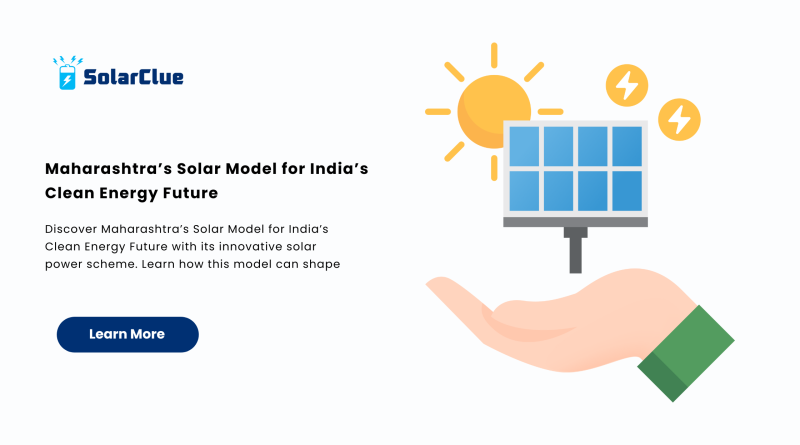Maharashtra’s Solar Model for India’s Clean Energy Future
Maharashtra’s Solar Model for India’s Clean Energy Future: India is undergoing a significant transition in the energy sector. The increasing need for sustainable, clean, and affordable power has pushed several states to look towards renewable energy sources. Among them, Maharashtra has taken the lead with its ambitious Mukhyamantri Saur Krushi Vahini Yojana 2.0 (MSKVY 2.0)—a groundbreaking initiative in the realm of solar energy. This comprehensive scheme not only promotes clean energy but also fosters economic development and environmental conservation, offering a scalable model for the rest of the nation.
Table of Contents
- 1 Understanding Maharashtra’s Solar Push
- 2 Decentralised Solar Power System: A Game Changer
- 3 Investment and Economic Impact
- 4 Environmental and Social Gains
- 5 Policy Execution and Governance
- 6 National Implications: A Blueprint for Bharat
- 7 Driving Sustainable Rural Development
- 8 Clean Energy for Industrial Relief
- 9 Boosting Gender Equity and Inclusion
- 10 Lessons from Phase One
- 11 Encouraging Private Sector Participation
- 12 Community Engagement and Ownership
- 13 Renewable Energy as a Job Creator
- 14 Long-Term Impact on India’s Climate Goals
- 15 Conclusion: A Vision Worth Replicating
- 16 FAQs
Understanding Maharashtra’s Solar Push
Maharashtra’s MSKVY 2.0 is the world’s largest decentralised renewable energy scheme designed to power agricultural operations through solar energy. With the aim of transitioning 100% of its agricultural power load—16,000 MW—to solar power, the scheme addresses multiple challenges faced by rural India, including erratic power supply and increasing electricity costs.
Decentralised Solar Power System: A Game Changer
One of the most innovative aspects of MSKVY 2.0 is its decentralised solar power system. Rather than depending on centralised generation units, Maharashtra is promoting smaller, localised solar plants (2–10 MW) near rural substations. This strategy reduces transmission losses, ensures better power quality, and guarantees reliable daytime electricity for farmers.
Investment and Economic Impact
This transformative project is set to attract investments of ₹68,000 crore. It promises to generate over 70,000 rural jobs, contribute ₹8,000 crore in tax revenue, and save ₹7,500 crore annually in agricultural subsidies. The implementation of such a solar power initiative not only makes renewable energy a viable economic engine but also directly benefits the state’s socio-economic fabric.
Environmental and Social Gains

With an annual reduction of 21.78 million tonnes of CO₂ emissions, MSKVY 2.0 plays a pivotal role in fighting climate change. By replacing fossil fuel-powered irrigation with solar energy, the state contributes significantly to India’s net-zero goals. Furthermore, the scheme promotes community participation, women’s empowerment, and grants for panchayats—ensuring inclusivity.
Policy Execution and Governance
The success of MSKVY 2.0 lies in its governance. The dedicated Maharashtra Solar Agro Power Limited (MSAPL) acts as a nodal agency, streamlining processes through single-window clearances, a land bank portal, and transparent tendering. These efforts remove bureaucratic bottlenecks, making it easier for developers and investors to participate.
National Implications: A Blueprint for Bharat
Maharashtra’s initiative complements the central government’s PM-KUSUM scheme. However, the state’s localised execution highlights the critical role of state-level governance in solar power system rollouts. If adopted nationwide, similar models could drastically reduce industrial tariffs, improve renewable energy compliance, and enhance rural incomes.
Driving Sustainable Rural Development
Access to reliable daytime solar power significantly impacts rural productivity. It enables better irrigation scheduling, reduces diesel use, and encourages the cultivation of high-value crops. Over time, such benefits lead to stronger rural economies and food security.
Clean Energy for Industrial Relief
By shifting agricultural loads to solar energy, Maharashtra alleviates the burden of cross-subsidies borne by industries. This translates to lower tariffs for manufacturing and services, enhancing the state’s competitiveness and encouraging industrial growth.
Boosting Gender Equity and Inclusion
Women in rural Maharashtra often face restrictions due to power unavailability. Daytime solar energy access changes this narrative—empowering women to participate more actively in agriculture and allied activities.
Lessons from Phase One
The MSKVY 2.0 model integrates lessons from its earlier phase. By using GIS-based land identification and digital dashboards, Maharashtra has eliminated many traditional pain points like land acquisition delays and opaque bidding systems.
Encouraging Private Sector Participation
A revolving payment security fund ensures timely payments to developers, reducing risk and enhancing confidence among private investors. Transparent policies and incentives have led to increased participation from reputed solar developers across India.
Community Engagement and Ownership
Beyond infrastructure, the program promotes local ownership. Panchayats hosting solar plants receive annual grants, strengthening local governance and encouraging communities to protect and maintain the assets.
Renewable Energy as a Job Creator
From engineers to technicians to maintenance workers, renewable energy is fast becoming a major employment generator in rural India. MSKVY 2.0 is estimated to create 70,000 direct and indirect jobs, particularly in Tier 2 and Tier 3 regions.
Long-Term Impact on India’s Climate Goals
India aims to achieve 500 GW of non-fossil fuel energy capacity by 2030. Maharashtra’s solar journey contributes substantially to this goal, showcasing how state-level leadership can accelerate national climate commitments.
Conclusion: A Vision Worth Replicating
The Maharashtra solar revolution is more than a regional success—it’s a national opportunity. With the right blend of policy, technology, and community, the state has shown a path toward sustainable energy and inclusive growth. Other states must seize this blueprint to transform India into a clean energy powerhouse.
To learn more about solar solutions and explore how you can be part of India’s renewable energy journey, visit solarclue.com. For deeper insights, case studies, and updates, check out our blog at blog.solarclue.com.
FAQs
1. What is MSKVY 2.0 and why is it important?
MSKVY 2.0 is Maharashtra’s state-run renewable energy scheme to solarize its agricultural power load. It’s important because it reduces CO₂ emissions, creates rural jobs, and sets a model for other states.
2. How does the decentralised solar model work?
It uses smaller solar power plants near substations, reducing transmission losses and providing consistent daytime electricity to farmers.
3. Can other states replicate this model?
Yes, with the right policy, local governance, and public-private partnerships, MSKVY 2.0’s success can be replicated across India.
4. How does this benefit the rural economy?
By ensuring energy reliability, reducing costs, and creating employment, solar energy drives rural development and agricultural productivity.
5. What role does clean energy play in climate change mitigation?
Clean energy like solar reduces greenhouse gas emissions, helping India progress toward its climate commitments and net-zero targets.
Curious to explore how solar can benefit your home, business, or community? Dive into our solutions today at solarclue.com—where the sun meets smart living!



